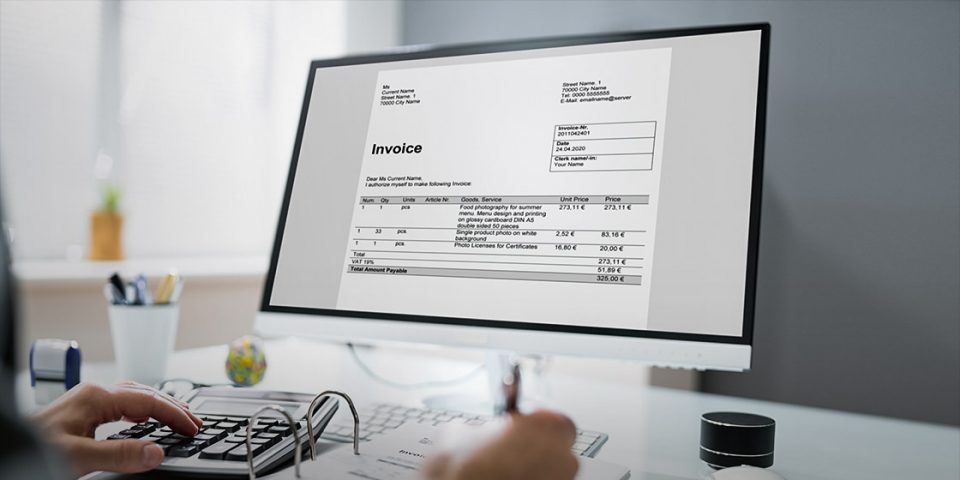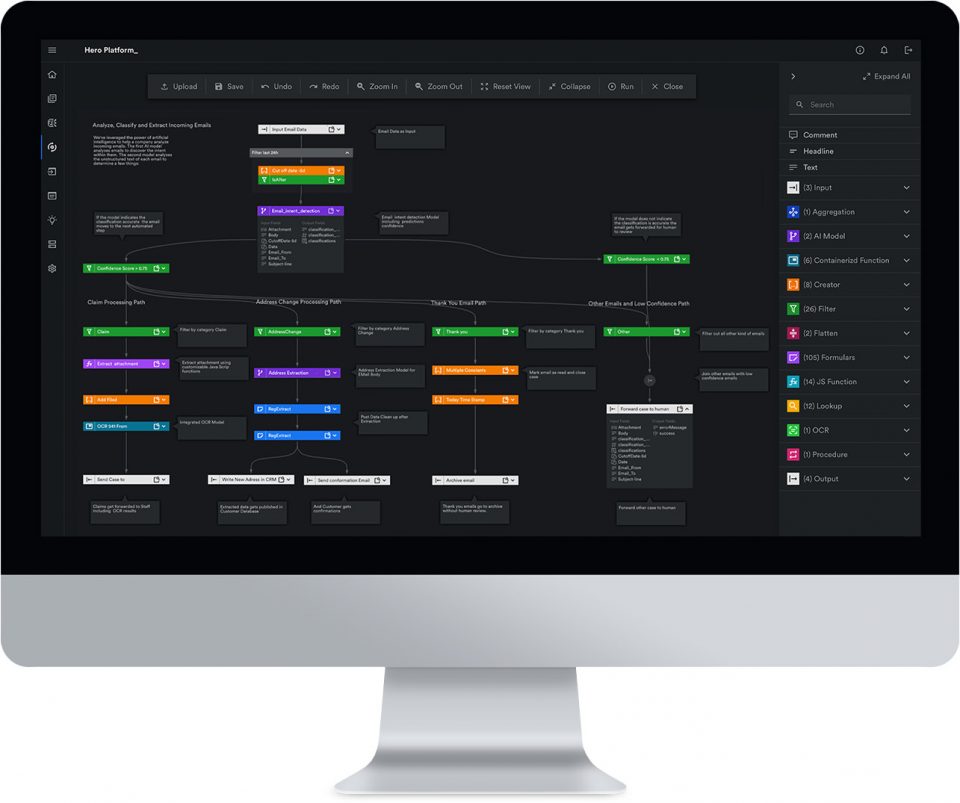Invoice automation: how does automated invoice processing work?
“Nothing is certain except death and taxes.”
In the business world, that phrase might as well include invoice processing. After all, the basis of every professional relationship is the transaction. If that gets bottlenecked, things can turn sour, potentially even damaging the company’s reputation.
Apr 06, 2023 by Craig Woolard

Invoice automation and modern AI have combined forces to revolutionize the accounts payable process. At Automation Hero, we help multinational enterprises free themselves from mountains of data-packed invoices so that they can pay their bills lightning-fast. After all, where would the most successful companies be without the support of vendors?
Keep in touch
What are the biggest problems in invoice processing?
Paying bills on time is often seen as a reflection of a brand’s image, and most brands want their invoices to be unique. However, the biggest problem in invoice processing is simple: everyone’s invoices look different.
Before we get into how automated invoice processing works, let’s examine the holistic pain points enterprises have with the accounts payable process:
1. Invoices are semi-structured documents
Invoices are semi-structured documents, meaning they do not have a standardized layout. Invoices have the same fields — think date, the amount due, and invoice number — but layouts change vendor-to-vendor. Therefore, organizations handling these documents may need help predicting where the information of interest is located on each incoming invoice.
2. Manual invoice processing is expensive.
Manually processing invoices takes a lot of time and staffing. Many organizations have seasonal increases in invoices that may even require additional staff. Each invoice requires someone to carefully read it, search through records to validate it’s a legitimate bill, confirm it’s for the correct amount, and input the data from the invoice. Additionally, a second person must usually be involved when approving and remitting payments.
3. AP processes require people
The next problem in invoice processing is more complex: invoices need people to review, validate, and approve purchase orders. Every organization has decision-makers with the authority to approve or deny invoices. Procurement managers, accounting departments, CFOs, and VPs are often involved in this complicated workflow.
4. Complicated workflows
Many companies receive invoices with different requirements, values, and data that must be manually keyed into an ERP (Enterprise Resource Planning) or another accounting system and pass through four-eye or even six-eye review audits. Unfortunately, there’s no “one-size-fits-all” solution for processing invoices. As a complex workflow, accounts payable processes need key people involved in the auditing process with multiple touchpoints between different systems, databases, and departments.
5. More room for human error
Processing each invoice requires full-time departments, but whenever humans have to perform detailed, repetitive work, there’s always the potential for costly mistakes. It can be easy to misread a number or miss a step in manual review processes, resulting in approvals that never should have been granted or misfiled documents that throw off an audit. Mistakes are expensive to fix. Any time a mistake is made, it takes additional time, staff, and expensive resources to correct it.
6. Bottlenecks delay critical payments
When human error and labor-intensive processes combine, the possibilities of delays are amplified, which might not be something your organization can afford. After all, the basis of every professional relationship is the transaction. When that gets bottlenecked, things can quickly turn sour. For example, with manual invoice processing, you risk losing vendors that offer great prices and services simply because of a bottleneck that prevented someone from paying a bill on time. Late invoices can incur penalties and impact corporate relationships, causing companies to lose discounts.
7. Poor visibility
When invoices are processed manually, records of every step are rarely stored in a central location (assuming they’re stored at all). Records management systems are expensive to maintain. Filing cabinet systems consume physical space, and the documents are difficult to retrieve, making it more challenging to know where mistakes occurred during an audit and who might be responsible for making them. Even more, it can be difficult to see opportunities for streamlining the process since it’s hard to track how long each step takes.
8. No centralized workflow
Incoming invoices come through various channels and in all kinds of different formats. Whether snail-mailed as paper documents, emailed as PDFs, or uploaded to an online vendor portal, incoming invoices come in various forms. With paper invoices still involved, additional staff must manually track and cross-check each one.
Accounting is complicated, which makes the accounts payable process even more complex for large enterprises looking to pay their bills efficiently. All of the various touch points must work cohesively, and adhere to each type of invoice’s workflow requirement.

What are the different types of invoices?
Depending on your industry, the invoices you receive can vary widely depending on the goods or services you purchase. However, the following are the most common invoices that large multinational enterprises receive:
- Standard Invoices: lists the goods or services provided, their prices, and the total amount due.
- Recurring Invoices: Many large enterprises have ongoing contracts or subscriptions for services that require recurring invoices.
- Purchase Order Invoices: This type of invoice is commonly used in B2B transactions when the buyer has issued a purchase order and received it from the seller.
- Progress Invoices: This invoice type is common in construction projects or other long-term contracts with ongoing projects. These show the amount due for work completed to date.
- Credit Invoices: This type of invoice is issued when a customer returns goods or cancels services, and credit is due. Large enterprises may receive credit invoices from vendors due to their transaction volume.
- Debit invoices: A debit invoice increases the amount due from a customer, typically when additional goods or services are provided. Large enterprises may receive debit invoices if they request other services or products.
As we can see, there’s no “one-size-fits-all” approach to accounts payable processes. While there are many variations and types, in general, invoices can be grouped into two categories:
- Invoices associated with a company’s internal request (PO order).
- These invoices have a purchase order number.
- Invoices not associated with a request (non-PO).
- These may not have a PO order.
It’s common for companies to have one approach for PO invoices and a different approach for non-PO invoices. They can be sent via email, mail, fax, or EDI. Regardless of how incoming invoices come through, paying bills on time is fundamental to running almost every type of company. What if there was a way to eliminate the busy work?
That’s where invoice process automation comes in, which we will cover in the next section.
What is automated invoice processing?
Invoice processing automation involves enterprise-grade technology and software to streamline the handling, processing, and management of incoming bills from arrival to payment.
Invoice automation can help a company’s accounts payable department streamline AP processes and invoice management procedures by automatically paying supplier/vendor invoices on time.
The technology behind invoice processing automation usually starts by extracting invoice data from incoming documents and inputting the data into an ERP or accounts payable system, enabling payments to be made in minutes.
What is invoice automation software?
Invoice automation solutions may involve intelligent document processing (IDP), robotic process automation (RPA) software, and artificial intelligence (AI) to automate the manual data entry tasks associated with the bill processing cycle — including reviewing, approving, remitting, and matching invoice data with the data from purchase orders and receipts.
How does automated invoicing work?
The invoice submission and approval process typically follows a specific series of steps:
- Document capture (the receipt of documents via email or scanned paper documents)
- Incoming invoices might arrive in a specific email folder as attachments (JPEG, PDF, EDI, PNG, etc).
- Document classification (Is this document an invoice?)
- AI intent classification models can identify which emails have attached invoices, automatically sort those emails, triage them, or route invoices to the appropriate person for approval.
- Data extraction (Invoice processing)
- Invoice automation software extracts critical data points from attachments with Optical Character Recognition (OCR).
- Analysis and validation (interpreting the invoice data according to business rules)
- If extracted values pass all validation rules, the invoice moves to “Verified.”
- If extracted values don’t pass validation rules, documents remain in “Review” unless manually reviewed and moved to “Verified” by a human in the loop.
- Data transformation (automatic data entry into a database)
- Converts images into text data that can be used by other systems.
- A final report is generated containing all invoice data.
- Critical data is exported as .csv or integrated with the ERP system.
- Invoice archiving (invoices are stored in a central repository for future use)
- The organization marks the invoice as “Paid” and archives the invoice in event of an audit, where it can serve as a valuable tool for detecting bookkeeping errors or embezzlements.
Watch this demo to see how our AI-driven platform can increase the accuracy and speed of your company’s processing workflow.
What are the limits of legacy automation solutions?
In the early 2000s, much of the “busy work” involved with invoice processing was taken over by robotic process automation (RPA), including data entry, price matching, and purchase orders.
Since robotic process automation (RPA) can mimic the keyboarding and manual click-work performed by human knowledge workers, legacy RPA can handle some rote busywork.
However, watch this demo to see where RPA falls short.
Legacy RPA is fragile and difficult to update
Since invoices are “semi-structured,” unfortunately, this is one area where traditional RPA falls short. Since legacy RPA uses a “rules-based” template for each invoice layout, there are real-world limitations regarding invoices. For example, since every vendor uses a unique layout, the “brittle” script-based technology breaks easily, making updating incredibly difficult.
RPA is burdensome and inflexible to maintain
Whenever vendors change the invoice layout that your RPA template is built on top of, the entire automation breaks, and the workflow needs to be rebuilt all over again. Additionally, separate workflow automations must be created for each new invoice you receive, further driving the disillusionment about RPA as a “brittle” and unreliable technology.
The only way to reach above-human accuracy is to go beyond the traditional template-based approaches. Modern invoice automation needs modern AI.
Invoice automation requires modern AI
In an automated invoice system that uses AI to process invoices, it doesn’t matter if the layout of invoices changes. This is because AI-powered automations can “learn” the structures of each invoice and process them no matter which vendor sends the invoice.
Intelligent document processing (IDP) is one example of artificial intelligence in invoice processing automation. IDP uses AI, machine learning, and computer vision to “read” invoices with above-human accuracy and extract critical data from them.
Modern invoice processing needs more than AI
There are a lot of AI solutions offering a human-in-the-loop (HITL) component as a “verification” tool. Some of the AI solutions on the market only let you verify the data coming from the AI. These HITL components are solely focused on handing off the data to humans so they can correct it when the machine gets something wrong.
Your AI could be perfect at doing this, especially if you have a PO system where you only need to validate three key fields. However, these HITL AI solutions offer a very limited role for human decision-makers to play in a workflow. What if additional decision-makers need to review an invoice? Depending on the size of the payment and your company’s size, you might also have accounting business rules requiring a four-eye or six-eye review process.
That’s why modern invoice automation needs more than AI. It needs key decision-makers in the loop.
Especially in larger enterprise organizations, you need the capability to build automation workflows with dedicated human-in-the-loop (HitL) skills that are not review-focused for the accuracy of the AI. You also need the ability to send email alerts with critical information to these key decision-makers for an extra layer of security, with the capability to build it out iteratively.

IDP: Agile workflow integration for the modern enterprise
When integrating any new technology, the failure to impact the core problem that needs resolution is a genuine concern. Errors in the implementation could carry real costs that ripple beyond your automation. For example, the time and money invested in projects that don’t move into production are at stake. To be agile, modern organizations need to build out iteratively, and the build-out must be flexible enough to continue iterating on the process. What you change today via automation may need more adjustment in a year.
Automation Hero’s Hero Platform_ is the only IDP platform that automates the entire invoice automation workflow. It offers a full-service no-code environment, a flexible HITL skill-builder, and native AI/cognitive intelligence with workflow integration via API at the platform’s core, making it easy to build, test, refine, and deploy, or expand your automation with stability and scalability.
Contrast this to traditional RPA, where the automation grows so complex that you throw it out and rebuild it all over again — instead of debugging and expanding the current implementation.
Our easy-to-use and flexible HitL interface enables multi-party reviews and approvals for large invoices — turning randomized audit approvals and other AP compliance protocols into a streamlined, collaborative process that guarantees an extra layer of security. Most HitL interfaces are just rules-based user interfaces, but ours offers greater flexibility than that.
Additionally, Hero Platform_’s microservice architecture allows us to solve specific invoicing problems as we plug into existing workflows. For example, supercharge an ERP system with intelligent document understanding or augment your current RPA with AI capabilities.
Our IDP technology is essential for enterprises looking to improve invoice processing speed, accuracy, and agility in the modern landscape.
Get started unlocking the intelligence in your invoices with AI-driven automation today
- Speak with an expert — tell us about your specific use case.
- Get a personalized demo — schedule a demo, and our Heroes will get in touch!
Close Window
Automation Hero will track how you use the emails (e.g., at what time you open which part of the emails) sent by Automation Hero. If you have provided a separate declaration of consent that cookies for tracking your usage of the website and/or apps may be placed on your device, Automation Hero will also connect the information about your use of Automation Hero’s websites and apps (e.g., which information you open) collected by the tracking cookie to such information in so far as possible. Automation Hero will analyze such information, to identify your interests and preferences and to communicate with you in a more personalized and effective way, e.g. by providing information that you are likely interested in, like information on new technologies or products of the Automation Hero group that are likely relevant to you.
